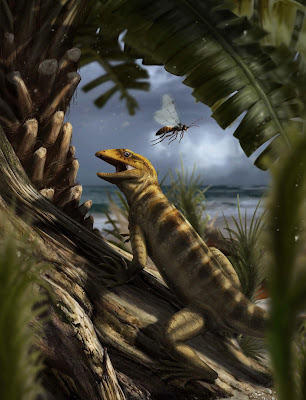 |
| Megachirella wachtleri
Renesto & Posenato, 2003
Simões, Caldwell, Tałanda, et al., 2018
Illustration: Davide Bonadonna nature.com
|
Abstract
Modern squamates (lizards, snakes and amphisbaenians) are the world’s most diverse group of tetrapods along with birds and have a long evolutionary history, with the oldest known fossils dating from the Middle Jurassic period—168 million years ago. The evolutionary origin of squamates is contentious because of several issues: (1) a fossil gap of approximately 70 million years exists between the oldest known fossils and their estimated origin; (2) limited sampling of squamates in reptile phylogenies; and (3) conflicts between morphological and molecular hypotheses regarding the origin of crown squamates. Here we shed light on these problems by using high-resolution microfocus X-ray computed tomography data from the articulated fossil reptile Megachirella wachtleri (Middle Triassic period, Italian Alps). We also present a phylogenetic dataset, combining fossils and extant taxa, and morphological and molecular data. We analysed this dataset under different optimality criteria to assess diapsid reptile relationships and the origins of squamates. Our results re-shape the diapsid phylogeny and present evidence that M. wachtleri is the oldest known stem squamate. Megachirella is 75 million years older than the previously known oldest squamate fossils, partially filling the fossil gap in the origin of lizards, and indicates a more gradual acquisition of squamatan features in diapsid evolution than previously thought. For the first time, to our knowledge, morphological and molecular data are in agreement regarding early squamate evolution, with geckoes—and not iguanians—as the earliest crown clade squamates. Divergence time estimates using relaxed combined morphological and molecular clocks show that lepidosaurs and most other diapsids originated before the Permian/Triassic extinction event, indicating that the Triassic was a period of radiation, not origin, for several diapsid lineages.
 |
| A life scene in the Dolomites region, Northern Italy, about 240 million years ago, with Megachirella wachtleri walking through the vegetation.
Illustration: Davide Bonadonna
|
The cover shows an artist’s impression of the Middle Triassic lizard Megachirella wachtleri. Found in the Italian Alps, the fossilized remains of this creature were first described in 2003. In this issue, Tiago Simões and his colleagues unveil a detailed analysis of the fossil using high-resolution microfocus X-ray computed tomography. The results shed fresh light on the origins of squamates — the group of reptiles that includes lizards and snakes. The team found that M. wachtleri is 75 million years older than other oldest known squamate fossils, thereby partially plugging a gap in the fossil record. Their phylogenetic analysis puts the emergence of geckos ahead of iguanians in the evolution of squamates and shows that the initial diversification of the major reptile lineages occurred before the Permian–Triassic boundary 252 million years ago. nature.com/nature/volumes/557/issues/7707
Tiago R. Simões, Michael W. Caldwell, Mateusz Tałanda, Massimo Bernardi, Alessandro Palci, Oksana Vernygora, Federico Bernardini, Lucia Mancini and Randall L. Nydam. 2018. The Origin of Squamates Revealed by A Middle Triassic Lizard from the Italian Alps. Nature. volume 557, pages 706-709. DOI: 10.1038/s41586-018-0093-3
The mother of all lizards found in Italian Alps phys.org/news/2018-05-mother-lizards-italian-alps.html via @physorg_com
World's oldest lizard fossil forces rethink of reptile family tree theguardian.com/science/2018/may/30/worlds-oldest-lizard-fossil-forces-rethink-of-reptile-family-tree


